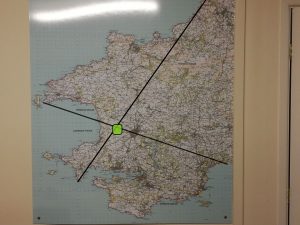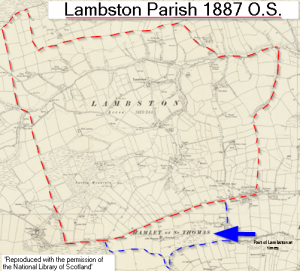Lambston Parish
“Lambston? Where’s that?” is a pretty common response when you say you are researching a local history project on Lambston; this is the case even from people who have lived in mid-Pembrokeshire all their life. If you take a map of Pembrokeshire and stretch a string from Cemais Head, the most north-easterly point in Pembrokeshire to St Anne’s Head in the west and then stretch another string from Telpyn Point in the extreme south east of the county to the most westerly part of north Pembrokeshire, Pen del Aderyn, to the south of Whitesands; the strings cross in Lambston parish, so it can perhaps claim to be the most central place in Pembrokeshire.

There is perhaps a good reason for this bemusement. It is a parish which no longer exists as a community unit having been merged with Camrose, nor does it have a parish church in use. When you mention the largest settlement in the parish ‘Portfield Gate’ most people know where you mean because the main Haverfordwest to Broad Haven road passes through it. But if you mention the other two much more ancient settlements of ‘Sutton’ and ‘Lambston’ the confusion returns. Neither of these two places are on the way to anywhere – or if they are, they are not on the regular route to the place which most people take. In addition, while Sutton is a reasonable sized hamlet, (albeit with a name that sounds more like southern England than Pembrokeshire), Lambston – the main settlement dating back at least 900 years only has one farmhouse, one bungalow and the church of St Ismael, now converted to a holiday home.
If you look at most history books about Pembrokeshire you rarely find any reference to Lambston and if you do, the reference is nearly always to the church. Occasionally you will find a reference to the little-visited Quaker Burial Ground, to the excavation of an Iron Age rath at Walesland or a mention of the Baptist chapel at Sutton but in general this seems to be a place where nothing much has happened.
So why choose Lambston? Surely if you are going to choose a parish for a landscape history you would choose one with a dramatic landscape, a detailed mining history, lots of records of trading, the exceptional remnants of an ancient farmed landscape perhaps. Lambston has none of these.

I chose it because I live here, I am curious about the place and could not find anything in the usual sources. Since starting to research I wonder if there is a value in looking at the ordinary rather than the exceptional – in that most parishes in Pembrokeshire are founded on agriculture and the studies tend to be about the exceptions. There is also the argument that actually interesting things have happened, they just have not been well recorded – if you use this website, I hope you will agree with me.